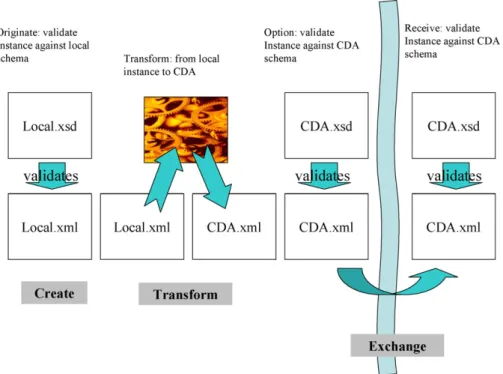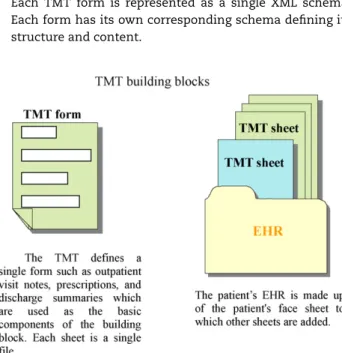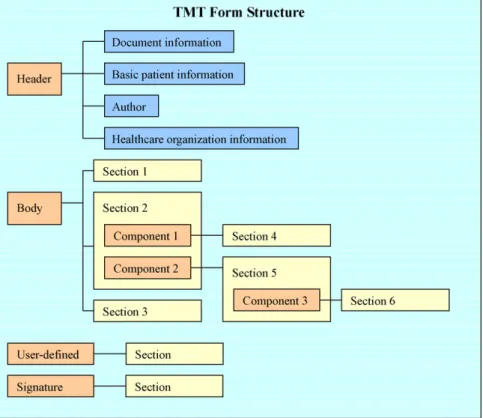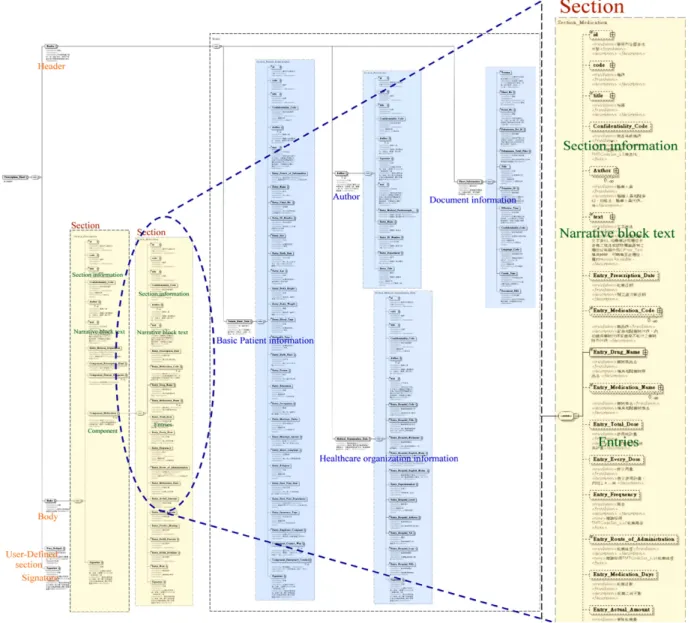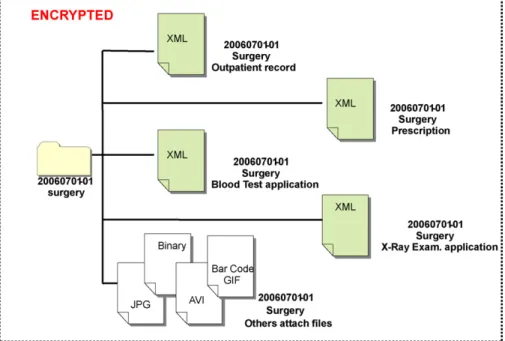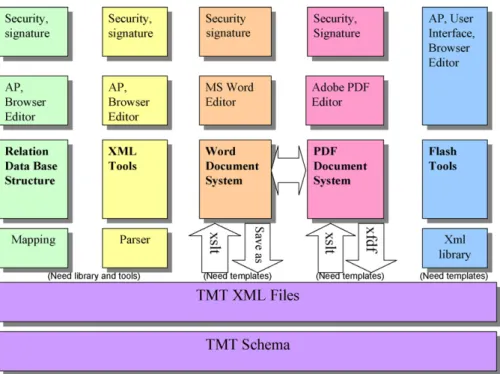j o u r n a l h o m e p a g e : w w w . i n t l . e l s e v i e r h e a l t h . c o m / j o u r n a l s / c m p b
Building a portable data and information interoperability
infrastructure—framework for a standard Taiwan
Electronic Medical Record Template
Wen-Shan Jian
a,b,f, Chien-Yeh Hsu
c, Te-Hui Hao
d, Hsyien-Chia Wen
b, Min-Huei Hsu
c,
Yen-Liang Lee
e, Yu-Chuan Li
f,∗∗,1, Polun Chang
f,∗,1aInstitute of Public Health, National Yang-Ming University, Taipei, Taiwan bSchool of Health Care Administration, Taipei Medical University, Taipei, Taiwan cGraduate Institute of Medical Informatics, Taipei Medical University, Taipei, Taiwan dDepartment of Business Administration, Chang Gung University, Taipei, Taiwan eDepartment of Information, Kangning Hospital, Taipei, Taiwan
fInstitute of BioMedical Informatics, National Yang-Ming University, Taipei 11221, Taiwan
a r t i c l e
i n f o
Article history:
Received 11 January 2007
Received in revised form 6 July 2007 Accepted 30 July 2007 Keywords: TMT EMR EHR Template Schema Standard
a b s t r a c t
Traditional electronic health record (EHR) data are produced from various hospital informa-tion systems. They could not have existed independently without an informainforma-tion system until the incarnation of XML technology. The interoperability of a healthcare system can be divided into two dimensions: functional interoperability and semantic interoperability. Cur-rently, no single EHR standard exists that provides complete EHR interoperability. In order to establish a national EHR standard, we developed a set of local EHR templates. The Tai-wan Electronic Medical Record Template (TMT) is a standard that aims to achieve semantic interoperability in EHR exchanges nationally. The TMT architecture is basically composed of forms, components, sections, and elements. Data stored in the elements which can be referenced by the code set, data type, and narrative block. The TMT was established with the following requirements in mind: (1) transformable to international standards; (2) hav-ing a minimal impact on the existhav-ing healthcare system; (3) easy to implement and deploy, and (4) compliant with Taiwan’s current laws and regulations. The TMT provides a basis for building a portable, interoperable information infrastructure for EHR exchange in Taiwan.
© 2007 Elsevier Ireland Ltd. All rights reserved.
1.
Background
The data sources of a tradition electronic health record (EHR) are from various hospital information systems. They are not stored independently without the support of hospital infor-mation systems until the incarnation of XML technology.
∗Corresponding author. Tel.: +886 2 2826 7238. ∗∗Corresponding author. Tel.: +886 988262639.
E-mail addresses:polun@ym.edu.tw(P. Chang),jackli@ym.edu.tw(Y.-C. Li).
1 These authors contributed equally to this work.
The sharing of data among healthcare organizations not only imposes functional demands of the exchange but requires semantic communication as well. Usually, people develop standards and technology to achieve the above interoper-ability of data sharing. There are currently many standard development organizations (SDOs), such as Health Level Seven (HL7)[1]and Integrating the Healthcare Enterprise (IHE)[2],
0169-2607/$ – see front matter © 2007 Elsevier Ireland Ltd. All rights reserved. doi:10.1016/j.cmpb.2007.07.014
which are dedicated to developing their own standards for the above objectives. However, in order for this effort to suc-ceed, the development of a standard must take into account not only the means of achieving the stated objectives but also external factors such as the acceptance of the associated technology in order to reduce resistance to standardiza-tion.
2.
Interoperability of data exchange
EHRs are a part of a very complicated information system framework that involves many related standards, which are supposed to provide interoperability[3]within healthcare sys-tems such as HL7 Clinical Document Architecture (CDA)[4,5], openEHR[6], and ASTM Continuity of Care Record (CCR)[7,8]. For EHR data sharing, interoperability can be divided into two dimensions[9]: functional interoperability and semantic inter-operability.
From the IEEE [10], the definition of interoperability is given as the ability of two or more systems or components to exchange information and to use the information that has been exchanged.
Aguilar[11]defined interoperability as follows:
1. Functional and syntactic interoperability is the ability of two or more systems to exchange information through functionality and defined message structures so that this information is readable by humans on the receiving end; and
2. Semantic interoperability is the ability for information shared by systems to be understood at the level of formally defined domain concepts, so that the
informa-tion can be processed by computers on the receiving end.
3.
Why TMT?
CDA is an exchange specification, not an authoring speci-fication. Since the CDA is not deterministic for document creation[1], a set of EHR templates is required for local stan-dardized clinical documents. Current research around the world has indicated that implementation of an EHR sharing standard needs to take into account other relevant stan-dards and be localized in order to meet actual requirements. Examples include projects such as Japan’s Medical Record, Image, Text-Information Exchange (MERIT-IX or MERIT-9)[12], and a set of patient information exchange guidelines using Medical Markup Language (MML); HL7 and ASTM CCR for Continuity of Care Documents (CCDs); and Germany’s Stan-dardization of Communication between Information Systems in Physician Offices and Hospitals using XML (SCIPHOX) [13].
Taiwan needs a set of local standard EHR templates in order to achieve functional and semantic interoperability within the country. The TMT project is a milestone effort on the path to a fully interoperable and portable document-based EHR.
4.
Requirements for developing the TMT
The TMT was established with the following requirements in mind: (1) transformable to international medical infor-mation standards; (2) having a minimal impact on the existing healthcare system; (3) easy to implement and deploy,and (4) compliant with Taiwan’s current laws and regula-tions.
4.1. Transformable to international medical
information standards
The Taiwanese EHR format must be compatible with interna-tional medical information standards. We reviewed HL7 CDA, the most famous EHR exchange standard in the world. We obtained the following recommendation from The Clinical Document Architecture Release 2.0. The CDA is an exchange
specification, not an authoring specification. HL7 suggests the general approaches for EHR exchange[1]:
“General approaches: constrain or transform
• constrain: emit valid CDA directly from the authoring sys-tem using a schema that isn’t CDA
• transform: example - emit local XML, map to CDA.”
For technical considerations, the team used the transfor-mation approach for the TMT so that it will be transformable to CDA as seen inFig. 1.
4.2. Having a minimal impact on existing healthcare systems
In order to easily integrate into the current healthcare environ-ment, the TMT was designed to use forms as self-contained units, which are already commonly used by medical profes-sionals.
A request was sent to 598 hospitals nationwide, and 200 hospitals responded providing as many as 20,056 forms which encompassed almost all the different forms that can be found in a hospital.
The process of defining the TMT standard was composed of (A) collecting and examining forms by medical special-ists, (B) classifying the over 20,000 forms into 70 categories based on their similarities, (C) drafting TMT format propos-als by the research team, (D) meeting with experts to form a consensus, (E) encoding the TMT schema with reusable components, (F) building a prototype system for managing the TMT forms, and (G) releasing a schema for specific TMT forms.
The released draft proposal uses the common request for comments (RFC) approach to solicit comments from the public. Meetings were often held to try and arrive at a con-sensus for a specification that minimized difficulties and criticisms. We held nine technical committees (TCs), including those for Physicians, Traditional Chinese medicine, Nursing, Medications, Dental, Examinations and lab tests, Technology assessments, Standard harmonization, and ethical, legal, and social issues (ELSI). A technical steering committee (TSC) was set up along with multiple technical committees in each field. The TSC itself was comprised of about 30 experts (including all the chairs and co-chairs of each TC) who had the responsi-bility of directing and approving work on all final documents (Fig. 2).
Through collecting data, drafting the TMT standard, reviewing by experts, defining the TMT standard, studying related international standards, and accounting for conver-sion of standards, the TMT architecture was developed which utilizes the modality of forms, components, sections, and ele-ments to arrive at a TMT schema from the real world. By creating a system prototype and carrying out revisions, the resulting standard more closely matches the requirements of real-world applications.
After 3 years of development, the TMT is now up to version 2.0. It currently includes 70 EHR forms that are the building blocks of an EHR. The TMT is defined to present the state of an EHR at a single point in time, i.e., a snapshot of the medi-cal record at a specific point in time and to enable the sharing of EHRs between facilities. The TMT is an EHR template for functional interoperability and semantic interoperability. It does not affect a hospital’s process of creating the EHR, the internal document flow, or documentation of management messages.
4.3. Easy to implement and deploy
Our team is carrying out an evaluation project to validate the practicability of the TMT standard. The team evaluated three different levels of healthcare organizations to participate in the prototyping of the TMT system: a 650-bed medical center
(Wanfang Hospital, Taipei); a 200-bed local hospital (Kangn-ing Hospital, Taipei); and a clinic (Shinhe Clinic, Taipei). The preliminary results showed that in electronically sharing over 40,000 medical sheets in the TMT forms within 1 week, no mapping errors occurred.
4.4. Compliant with current laws and regulations
Legal professionals were invited to review all relevant laws which might pertain to the deployment of TMT in Taiwan, including the Medical Care Act, Physician Act,
Com-puterized Personal Information Act, Electronic Signature Act, Personal Data Protection Ordinance, and Healthcare Organization Electronic Medical Record Creation and Management Ordinance.
They concluded that the TMT can be deployed in a way compliant with all existing Taiwanese laws and regula-tions.
5.
The framework of the TMT
To reduce the complexity of the TMT and to take into account difficulties with practical implementation, the basic principle in the design of the TMT formats was to develop a set of tem-plates for representing the EHR contents at a certain point in time.
The focus was on the format for presenting the data contents. TMT documents were therefore designed to be a snapshot of the medical record at a certain point in time.
A basic building block of the TMT is its forms. When we create a patient’s EHR using the TMT standard, we generate sheets from each TMT form. The following paragraph provides the definitions for forms and sheets.
1. TMT form: Traditional paper forms such as outpatient notes, prescriptions, and test reports are treated as TMT forms. Each TMT form is represented as a single XML schema. Each form has its own corresponding schema defining its structure and content.
Fig. 3 – Forms and sheets in the Taiwan Electronic Medical Record Template (TMT).
Fig. 4 – Taiwan Electronic Medical Record Template (TMT) form structure.
2. TMT sheet: A sheet is an instance of a TMT form. Hence, a sheet is an XML file that contains data in a specific form. The TMT standard is composed of multiple schemas rep-resenting different forms in a medical record.
XML schemas[14]express shared vocabularies and allow machines to carry out rules made by people. They provide a means for defining the structure, content, and semantics of XML documents. There are currently more than 70 different TMT forms such as outpatient visits, lab reports, prescriptions, admission notes, etc. Each patient’s EHR will then contain multiple TMT sheets, which are instances of the previously described TMT forms (Fig. 3).
6.
The anatomy of a TMT form
Each TMT form is composed of four major parts: a header, body, user-defined section, and signature (Fig. 4).
6.1. Header
The header stores four different kinds of information, namely, the document information, basic patient information, author, and healthcare organization information. The document information contains items such as document ID, submis-sion ID (for document grouping), and set ID (for versubmis-sion
control). The basic patient information contains patient ID, gender, age, emergency contact, etc. The author information represents the humans and/or machines that authored the document. Healthcare organization information is given on the healthcare organization which is in charge of maintaining the document.
6.2. Body
The body of each form is where the main information is stored. Different forms have different layouts, but they all follow the basic section-component structure described inFig. 5.
6.3. User-defined section
This allows users to fit their own contents into a cus-tomized layout. The main function is to accommodate special data-capture needs of each organization. However, producing customized layouts could result in a lower level of interoper-ability.
6.4. Signature
The TMT form uses the W3C XML signature standard. This allows the incorporation of digital signatures of healthcare organizations and personnel.
6.5. Sections and components
The section is the main data structure in the body that include section information, a narrative block, entries, and compo-nents as shown inFig. 5. The section information covers such things as section ID, code, title, author, etc. The narrative block carries the human-readable text, while the entries carry machine-readable data. The components represent references to other sections which can be reused and included in this specific section. The team has defined more than 40 reusable TMT sections such as a basic patient information section, past medical history section, allergy history section, family history section, etc. This reduces the amount of redundant re-definition required while simplifying the procedure needed to define each TMT form.
7.
An example of a TMT form
The schema is an integral part of our EHR format definition. Through the use of the schema, users can quickly verify if a TMT sheet (an XML file) generated by the user conforms to our specifications.
TMT forms are modeled after traditional paper forms for medical records. So far, 70 TMT forms (schemas) have been completed, representing commonly used paper forms found in traditional medical records. An example of a pre-scription form representing the TMT schema is shown in Fig. 6. The schema of the prescription form is the simplest form of the TMT. Each form is composed of four major parts: a header, a body, a user-defined section, and signa-tures. The header includes sheet information, basic patient information, author, and healthcare organization informa-tion. The medication data section includes prescription date, medication code, medication name, total dose, unit dose, frequency, route of administration, etc. under the body section.
All 70 TMT forms are categorized into six major groups: outpatient, emergency, inpatient, nursing, reports, and others. The outpatient group, for example, includes a general out-patient encounter, progress encounter, dentistry encounter, Chinese medicine encounter, prescriptions, etc. A list of all TMT forms is given inTable 1.
8.
The concept of a submission set
A submission set refers to a collection of all medical records generated during a given consultation or visit to a specific healthcare organization. For example, one outpatient con-sultation may include an outpatient note, prescription, and laboratory test application form. And so on, while each hos-pital stay may result in an admission note, progress notes, operation notes, nursing records, etc. The header of each sheet therefore includes a submission set ID along with the total number of sheets in that group of submission to ensure com-pleteness of the data.
Each submission set can also be used as a unit for data encryption and/or a signature. This prevents the leaking of information from individual sheets leading to erroneous assumptions about the full contents of the EHR. A submission set can also include multimedia attachments such as JPEG, AVI, GIF, and other binary file formats (Fig. 7).
9.
Comparison with other international
EHR exchange standards from the user’s
perspective
Compared to other EHR exchange standards currently being developed, the TMT offers the following features.
Table 1 – Taiwan Electronic Medical Record Template (TMT) form classification
1. Outpatient 3. Inpatient
General outpatient encounter Admission note
Medical outpatient encounter Progress note
Surgical outpatient encounter Inpatient medical order
Family medicine outpatient encounter Consultation note
Gynecological outpatient encounter Discharge summary. . .
Pediatric outpatient encounter
Otolaryngology outpatient encounter 4. Nursing
Dermatology outpatient encounter Nursing problem record
Respiratory outpatient encounter Hospitalization nursing assessment form
Orthopedics outpatient encounter Nursing plan form
Optometry outpatient encounter Nursing record
Anesthesiology outpatient encounter Vital signs monitoring record
Psychiatric outpatient encounter Emergency nursing assessment form. . . Neurosurgery outpatient encounter
Neurology outpatient encounter 5. Test report form
Gastroenterology outpatient note Checkup application form
Radiology outpatient encounter Laboratory testing application form
Urology outpatient encounter Checkup report
Dentistry encounter Laboratory test report. . .
Chinese medicine outpatient encounter Prescription sheet. . .
6. Other
2. Emergency Patient health summary
Emergency trauma surgery note Transfer sheet
Emergency triage form Anesthetization record
Emergency assessment form Nutrition consultation record
Emergency medical order. . . Health education record
Surgery consent form Ambulance record Health checkup report. . .
Fig. 7 – Taiwan Electronic Medical Record Template (TMT) submission set structure.
9.1. Clearly defined data storage
The TMT uses a form-based representation in which each form from paper-based medical records has its own specific schema. This creates a system framework containing multiple schemas. Because the way data stored in each sheet is clearly defined, users can quickly locate any information.
9.2. Rapid technical implementation
Because of the form-based representation, an EHR form can be developed which incrementally represents the entire EHR. They need thorough browser system prototyping, and revisions can be performed form-by-form. This therefore sim-plifies the new system design and deployment.
9.3. Ease of learning
A single schema that represents the entire EHR not only increases structural complexity but also makes it difficult to learn. With the TMT’s form-based approach, users can begin with simpler forms while familiarizing themselves with the standard. Our experience showed that a physician can learn to read and revise a TMT form with a 10–15-min introduction.
9.4. Future expandability
The form-based design allows different forms in the medical record to be represented in independent schemas. If neces-sary, new schemas can be added in the future to expand the coverage of the variety of clinical documents.
9.5. Level of localization
Since the TMT standard was designed to accommodate local needs, it satisfies the requirement for region-specific localiza-tion.
Technical barriers also affect system implementation due to semantic interoperability among medical facilities. The TMT has very clear definitions of its exchange data contents. So, semantic interoperability can be achieved with the TMT.
10.
Discussion
The TMT is a standard that aims to achieve functional and semantic interoperability in EHR exchanges. Through Exten-sible Stylesheet Language Transformations (XSLT) technology, TMT XML files can be transformed into the HL7 CDA for-mat which can facilitate international interoperability in the future. In order to fit into the current environment, the TMT was designed using forms, a concept already familiar to med-ical professionals. For the project, we carried out system prototyping, training, and education and tried as much as was possible to ensure that the standard is easy to implement. We have reviewed all relevant laws which might affect EHR exchanges in Taiwan, and the TMT standard can be imple-mented in a way that complies with all current laws and regulations. The project has achieved the requirements of: (1) being transformable to international medical information standards; (2) having a minimal impact on existing healthcare systems; (3) being easy to implement and deploy; and (4) being compliant with current laws and regulations.
In 2007, the Department of Health (DOH) in Taiwan deter-mined to allocate about US$1 million to promote the TMT
Fig. 8 – Taiwan Electronic Medical Record Template (TMT) document transformation.
format in ten medical centers which collectively provide more than 10 million outpatient visits a year. This project will also help refine the TMT into a national standard for EHR docu-mentation and exchange in Taiwan.
During the past research time, the members of this team acquired many technical skills about XML, such as schema definition, XSLT, XQuery, and XPath languages. We now also better understand HL7 CDA, OpenEHR, ASTM CCR, and the IHE international standard. When we were building and testing an exchange prototype system to communicate among hos-pitals, we also learned more about technical barriers against semantic interoperability, such as the transfer data from HIS database to XML file.
Because of the maturity of the XML technical standards, such as XSLT, XPath, XQuery, etc., it is easy to transform a required document into a variety of document formats, as shown in Fig. 8. The XML technology is currently the mainstream choice of data packaging[15–17]for sharing infor-mation. It is also possible to use XSLT to convert among various medical information standards[18,19]. It is this adop-tion rate that will ultimately determine whether the standard is retained or discarded.
The design of the TMT format provides the basis for developing a document-based information standard and information interoperability infrastructure for the health-care system in Taiwan. With the help of the TMT, the document-based EHR can also be used for digital signatures and encryption of files that can be delivered to individual patients for personal health management purposes.
Acknowledgments
This research project (DOH no. 95A3310) was made possible with the aid of the Taiwan Association of Medical
Informat-ics and sponsorship of the Information Center, Department of Health, Executive Yuan, Taiwan along with contributions made by all the experts involved in the project.
r e f e r e n c e s
[1] HL7 Health Level Seven, available athttp://www.hl7.org/, accessed on 20 April 2007.
[2] IHE IT Infrastructure Technical Framework,
http://www.ihe.net/Technical Framework/index.cfm#IT, accessed on 20 November 2006.
[3] Paul Miller, Interoperability What is it and why should I want it?
http://www.ariadne.ac.uk/issue24/interoperability/intro.html, accessed on 30 May 2007.
[4] R.H. Dolin, L. Alschuler, S. Boyer, C. Beebe, F.M. Behlen, P.V. Biron, S.A. Shabo, HL7 Clinical Document Architecture, Release 2, J. Am. Med. Inform. Assoc. 13 (2006) 30–39. [5] R.H. Dolin, L. Alschuler, C. Beebe, P.V. Biron, S.L. Boyer, D.
Essin, E. Kimber, T. Lincoln, J.E. Mattison, The HL7 Clinical Document Architecture, J. Am. Med. Inform. Assoc. 8 (2001) 552–569.
[6] openEHR Archetypes,http://svn.openehr.org/knowledge/ archetypes/dev/index.html, accessed on 11 May 2006. [7] ASTM Committee E31 on Healthcare Informatics develops
standards,http://www.astm.org/cgi-bin/SoftCart.exe/ COMMIT/COMMITTEE/E31.htm?L+mystore+fdxl9438, accessed on 8 December 2006.
[8] D.C. Kibbe, J. Phillips, L.A. Green, The continuity of care record, Am. Fam. Physician 70 (2004) 1220–1223.
[9] D. Asuman, B.L. Gokce, K. Yildiray, U. Seda, Exploiting ebXML registry semantic constructs for handling archetype metadata in healthcare informatics, Int. J. Metadata, Seman. Ontol. 1 (2005) 21–36.
[10] IEEE standard computer dictionary, A compilation of IEEE standard computer glossaries, IEEE Std. 610, 1991.
[11] Aguilar, A. Semantic Interoperability in the context of eHealth,http://aguilar.deri.ie/papers/ehealth paper.pdf, accessed on 20 November 2006.
[12] MERIT-9 Project,http://merit-9.mi.hama-med.ac.jp/, accessed on 20 November 2006.
[13] K.U. Heitmann, R. Schweiger, J. Dudeck, Discharge and referral data exchange using global standards—the SCIPHOX project in Germany, Stud. Health Technol. Inform. 90 (2002) 679–684.
[14] XML Schema,http://www.w3.org/XML/Schema, accessed on 20 May 2007.
[15] S.C. Arnott, Effect of XML markup on retrieval of clinical documents, AMIA. Annu. Symp. Proc. (2003) 614–618.
[16] R. Schweiger, S. Hoelzer, K.U. Heitmann, J. Dudeck, DTDs go XML schema—a tools perspective, Med. Inform. Internet Med. 26 (2001) 297–308.
[17] R. Schweiger, S. Holzer, J. Dudeck, Advanced information retrieval using XML standards, Stud. Health Technol. Inform. 116 (2005) 677–682.
[18] J. Mijic, M. Tadic, M. Jancec, and G. Jovanov, HTML to XML conversion for non-programmers, 2005,
pp. 329–334.
[19] E. Wustner, T. Hotzel, and P. Buxmann, Converting business documents: a classification of problems and solutions using XML/XSLT, 2002, pp. 54–61.
